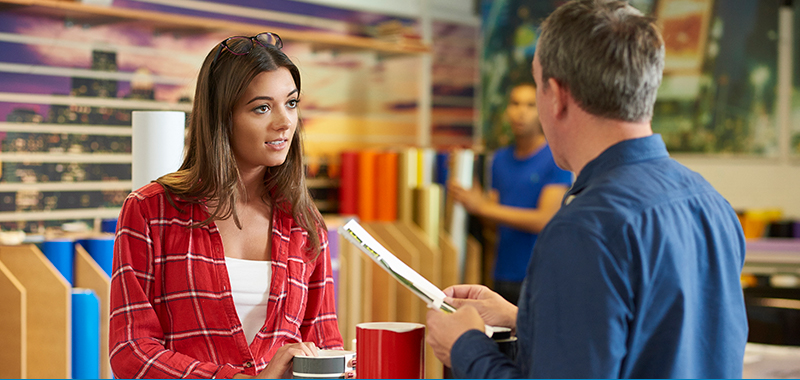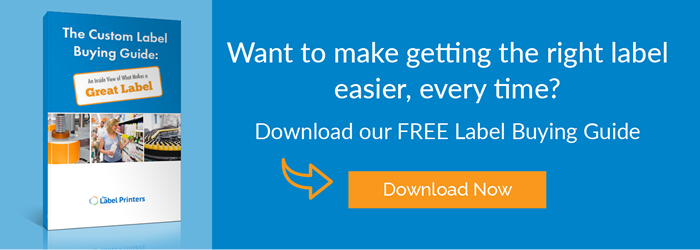
Maybe you need labels for a new product release, or you want to refresh the look of an existing product. Maybe you need warning labels or instructive labels to help users make the most of your products safely. Maybe you’re looking to advertise a sale, identify visitors to a museum, or commemorate an event.
A label may be lightweight, but it does a lot of heavy lifting. So, when it’s time to order custom labels, there’s a lot more to it than just “buying some stickers.”
Why Your Label Printer Seems So Inquisitive
People who are new to ordering custom labels are often surprised by the number of questions their printers ask. But your label printer isn’t trying to nose into your business—there’s a method to their madness.
You may not think much about the properties and performance of labels, but label printers think about it nonstop. This is because label disasters can and do happen if the label vendor doesn’t have the information they need to make the right choices. What’s at stake? Your label could peel off, smudge, fade, rip, and ultimately fail to fulfill its purpose—a fate that both you and your label vendor want to avoid.
Your label printer also wants you to not just have an okay label, but a great one. By asking questions, they’ll know which elements to recommend that will help you create a label that not only fulfills its purpose, but goes above and beyond with more detailed imagery, more vibrant colors, digital elements, and brand protection features.
If you don’t read this article beyond this point, at least take away this message: Your label printer will (and should) ask you questions. The more details you can give your label printer, the better your chances will be of getting the perfect label.
4 Questions Your Custom Label Printer May Ask
Here are a few of the questions your label printer will ask in their quest to get you the best label for your needs and budget:
1. To What Surface Will the Label Be Applied?
Why it matters: Adhesives (the sticky part of the label) perform differently depending on the application surface. What sticks to glass may not adhere as well to a porous surface, such as wood or cardboard, and vice versa.
To help you choose the right adhesive, your label printer may get as granular as the type of plastic a surface is made from. The curvature of surfaces and coatings on those surfaces, such as paint or powder, affect adhesion as well.
2. What Environmental Factors Will Your Label Be Exposed To?
Why it matters: The elements — heat, cold, moisture — can wreak havoc on a label that isn’t adequately prepared for them. Some adhesives, for example, aren’t meant for wet environments and can lose their grip when exposed to moisture. And we all know how untreated paper can deteriorate in the damp.
Think about the changes in heat and moisture a beer bottle goes through. It may go from being filled with 68-degree ale to being stored in a cold, dry refrigerator, to being transferred to an ice water-filled cooler. The bottle’s label needs to survive each transition intact.
Light — excessive sunlight, in particular — can cause some inks to fade. This can be a problem for safety labels on outdoor equipment. Certain industrial solvents can also wear away at the integrity of labels.
Your label printer will help you identify the right label materials, adhesives, and inks for your product’s typical environment.
3. What Purpose Will Your Label Serve?
Why it matters: Your label printer needs to know about your label’s purpose so they can ensure it will achieve your objectives for it. For example, if your product is to be used in an environment where it will be exposed to the elements or it will be splashed by liquids, provisions can be made to protect the printed image from those influences.
Your label may be subject to regulatory requirements, as well. Nutrition labels, for example, need to be formatted according to strict government specifications. Your label printer can help you to navigate some of the regulatory hurdles you might face.
If you’re interested in technology that can help protect your brand — such as using serial numbers and barcodes to support track-and-trace capabilities — your label printer can help you make the right decisions there, too.
4. What Do You Want Your Label to Look Like?
Why it matters: The imagery and colors of your label, its size, and its shape all play a role in determining the best materials to use, the most effective printing technology, and the cost of the label. Your label printer will also ask you how much you are willing to deviate from your appearance requirements.
For example, your brand’s specific shade of blue may not be available without utilizing in an expanded color palette or using a special ink for that color. But if you’re willing to accept a slight color variation from what you had planned, you might realize some savings.
Your label printer can also help you add appealing visual elements to make your label look even better than you thought possible. Metallic foils and inks can give your label the sheen of upscale luxury. Crinkled paper effects can make your label appear and feel handmade. You can even use QR codes to take your brand experience into the digital realm.
Be Ready for Your Next Conversation With a Label Printer
Talking with a label printer about your requirements and goals for your label shouldn’t be intimidating. A knowledgeable and experienced printer will ask the right questions and lead you through your options with patience and expertise. But if you want to get a head start on answering the questions your label printer may ask, read our free Custom Label Buying Guide.

